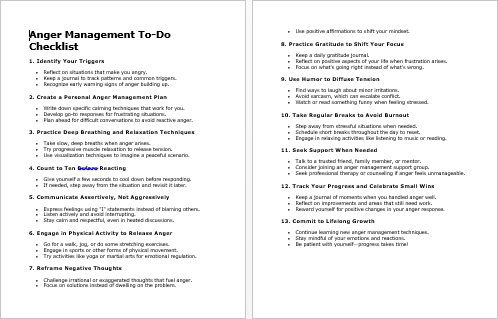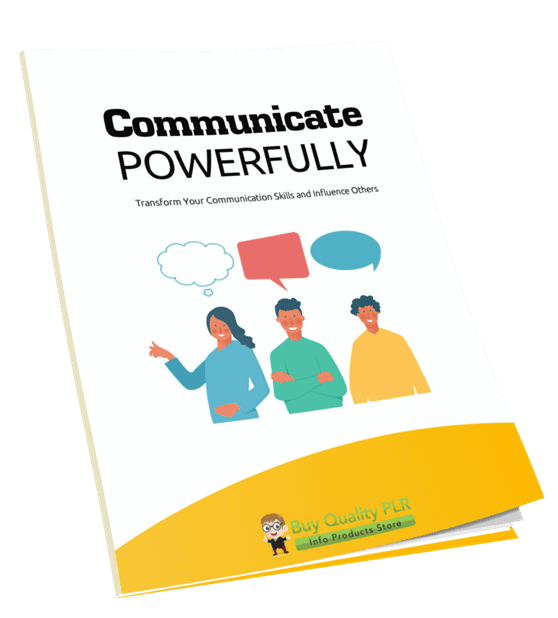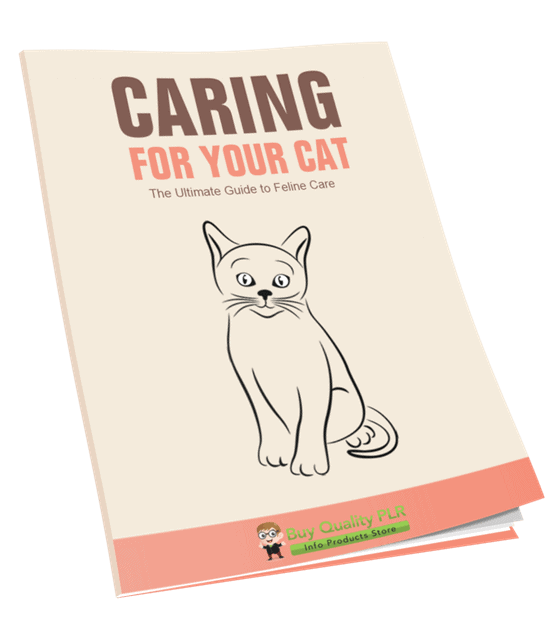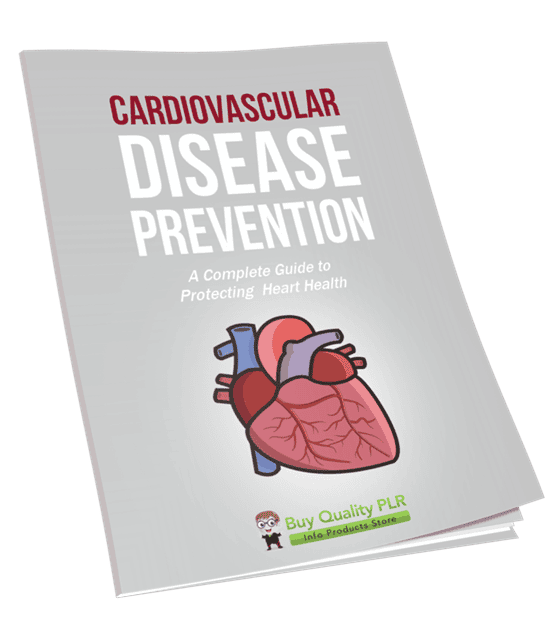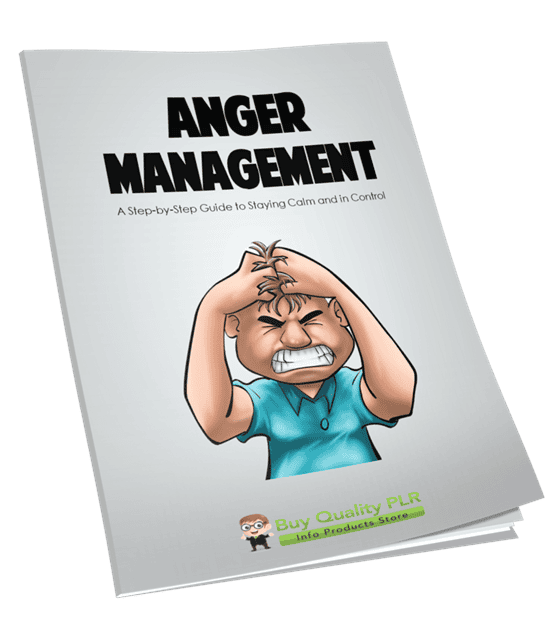
Anger Management PLR Course 22k Words
in Anger Management PLR , Anger Management PLR eBooks , PLR Checklists , PLR eBooks , PLR eCourses , PLR List Building Reports , Premium PLR , Premium PLR eBooks , Premium PLR Reports , Premium White Label Brandable PLR Coaching Courses , Private Label Rights Products , Self Help PLR , Self Help PLR eBooksChoose Your Desired Option(s)
has been added to your cart!
have been added to your cart!
#angermanagementplr #selfhelpplr #emotionalcontrol #mentalwellness #personaldevelopment #plrcourse #manageanger #stressrelief #mindfulness #angercontrol
Anger Management PLR Course – A Step-by-Step Guide to Staying Calm and in Control
Unlock the Power of Anger Management – Master Your Emotions and Build Healthier Relationships
Anger is a natural emotion, but if left unchecked, it can damage relationships, work productivity, and overall well-being. If you’re ready to take control of your anger and turn it into a positive force, this Anger Management PLR Course is for you!
With 20,450 words of expertly crafted content, this step-by-step guide will walk you through understanding your anger, controlling it before it takes over, and applying practical strategies that work in everyday life.
Whether you’re looking to help others or enhance your own anger management skills, this course provides actionable tools and exercises that can be implemented right away.
Presenting…
Anger Management PLR Course 22k Words
For just $14.99, this complete course package is ready for you to sell, rebrand, or use to enhance your personal or professional development.
What’s Included in the “Anger Management” PLR Course
This course is broken down into 5 detailed modules, giving you everything you need to manage and transform your anger into productive and positive outcomes.
Module 1: Understanding Your Anger
Gain insights into your anger triggers, emotional patterns, and reactions.
- Identifying Your Anger Triggers
Learn how to track your triggers and observe patterns that set off your anger. Identify and manage situations that make you angry. - Understanding the Science Behind Anger
Dive deep into how anger affects your brain and body, from the fight-or-flight response to physical signs like a tense body. - Recognizing Your Anger Style
Discover whether you express, suppress, or control your anger and why it matters in how you respond to conflict. - Assessing the Impact of Your Anger
Reflect on how unmanaged anger affects your life and relationships. Learn how to move from reactive anger to constructive responses.
Module 2: Controlling Anger Before It Controls You
Master practical tools and techniques to remain calm and in control before anger escalates.
- Practicing the 5-Second Pause
Implement a simple but effective pause to prevent rash reactions and to create space for thoughtful, calm responses. - Using Breathing Techniques to Stay Calm
Learn how to use the 4-7-8 breathing method and other calming techniques to control physical reactions and regain composure. - Reframing Negative Thoughts
Discover how to challenge and reframe negative thoughts, shifting from blame to positive solutions and greater understanding. - Using Physical Activity to Release Tension
Release anger’s built-up energy through physical exercise, helping you manage emotions more effectively in the long run.
Module 3: Communicating Anger in a Healthy Way
Learn how to express your anger in a respectful, effective manner that fosters understanding and avoids conflict.
- The “I-Statement” Formula for Expressing Anger
Communicate your anger constructively with I-statements, focusing on your feelings without blaming others. - Setting Boundaries Without Aggression
Master the art of setting respectful boundaries to protect your peace while avoiding aggression or confrontation. - Active Listening to Prevent Conflict
Learn how listening can help prevent escalations and improve communication, making it easier to de-escalate tense situations. - Knowing When to Walk Away
Understand that not every situation requires engagement and that walking away can preserve your emotional well-being.
Module 4: Long-Term Strategies for Anger Management
Build long-term habits that support lasting change and emotional control.
- Practicing Daily Stress Management
Learn daily practices like meditation and journaling to reduce stress and avoid letting frustration lead to anger. - Improving Emotional Intelligence (EQ)
Understand how to recognize and manage your emotions, improving self-awareness and your ability to react rationally instead of emotionally. - Practicing Gratitude to Shift Your Mindset
Replace anger with gratitude by focusing on what’s going well, fostering a sense of peace and positivity. - Seeking Support When Needed
Recognize when it’s time to reach out for support and how to talk to a therapist or support group for help.
Module 5: Applying What You’ve Learned (Final Steps)
Create your personalized action plan and apply what you’ve learned in real-life situations.
- Creating Your Personal Anger Management Plan
Write down your triggers and calming techniques to help stay on track when anger arises. - Practicing Real-Life Scenarios
Simulate challenging situations and practice applying your anger management techniques to develop confidence. - Tracking Your Progress
Keep a journal to track your progress and celebrate your successes along the way. - Committing to Lifelong Growth
Understand that anger management is a continuous process. Commit to ongoing self-improvement to maintain control and peace.
Included Bonuses:
- Anger Management Checklist (392 Words)
A quick reference guide to help you stay on track with your anger management practices. - Anger Management FAQs (946 Words)
Addressing common concerns and providing answers to help guide you through your journey. - Sales Page for Anger Management (583 Words)
A pre-written, high-converting sales page to help you sell the course immediately and start generating profits.
How to Use and Profit from the “Anger Management” PLR Course
With the Anger Management PLR Course, you have the flexibility to generate income in multiple ways. Here are some ideas to get started:
- Sell the Course as-is
Simply sell the PLR course directly to your audience for $14.99 or more, depending on the value you add. - Create Mini-Courses or Reports
Break the course into bite-sized portions and sell individual reports or modules for $10-$20 each. - Bundle with Other Content
Combine this course with other self-help, mental wellness, or emotional intelligence content and sell the bundle for $47-$97. - Membership Site
Set up a membership site where customers can access exclusive anger management content and resources. Charge a monthly subscription for ongoing support. - Offer a Coaching Program
Use the course content as the foundation of a coaching or group program. Charge $297-$497 for personalized support and guidance. - Convert into Audio or Video Formats
Transform the course into podcasts, videos, or webinars and sell as premium content or offer it as part of your membership site. - Use as Lead Magnets
Excerpt parts of the course and offer them as free reports, blog posts, or email sign-ups to attract and grow your audience.
License Terms: What You Can and Can’t Do
What You Can Do:
- Sell the content as-is or rebrand it to suit your style.
- Break it up into smaller portions and sell them for $10-$20 each.
- Bundle it with other related content to create a product worth $47-$97.
- Create membership sites, coaching programs, or e-classes.
- Use it to create physical products or audio/video content.
What You Can’t Do:
- You cannot pass on PLR rights or reprint rights to your customers.
- You may not offer 100% commission on affiliate sales (maximum 75% commission).
- The content must be sold and cannot be given away for free in its original form.
- You cannot add this content to any pre-existing customer orders unless they make an additional purchase.
Get Started Today – Only $14.99!
Don’t miss out on this powerful, ready-to-sell Anger Management PLR Course. This course is designed to help people understand, manage, and overcome anger in a positive and productive way. Whether you’re selling the course to others or using it to develop your own skills, you’ll benefit from this comprehensive, actionable content.
Master Anger Management and Transform Lives
Start your journey to better emotional control and healthier relationships today. With the Anger Management PLR Course, you’re just a step away from mastering your emotions and helping others do the same.
has been added to your cart!
have been added to your cart!
Here A Sample of Anger Management PLR Course
Anger is a natural emotion, but if not managed properly, it can harm our relationships, work, and overall well-being. This course will guide you through practical strategies to understand, control, and transform your anger into a positive force. Let’s get started!
Module 1: Understanding Your Anger
Before we can manage anger, we need to understand it. This module helps you recognize your triggers, emotions, and reactions.
Step 1: Identifying Your Anger Triggers
Anger is a natural human emotion, but when left unmanaged, it can negatively impact relationships, work, and personal well-being. The first and most crucial step in anger management is identifying what triggers your anger. By understanding the root causes, you can take control of your emotions rather than letting them control you.
Understanding Anger Triggers
Anger triggers are specific situations, people, or experiences that provoke an angry response. These triggers vary from person to person and can be external (events happening around you) or internal (thoughts, memories, or expectations). Some common anger triggers include:
- Workplace stress – Tight deadlines, uncooperative colleagues, lack of recognition, or overwhelming workloads.
- Traffic and delays – Long commutes, rude drivers, or unexpected delays.
- Personal relationships – Disagreements with family, friends, or romantic partners.
- Unmet expectations – Feeling let down when things don’t go as planned.
- Feeling disrespected – Being ignored, criticized, or treated unfairly.
- Financial stress – Struggling with bills, unexpected expenses, or job insecurity.
Action Step 1: Reflect on Situations That Make You Angry
Start by thinking about the last few times you felt angry. Consider the following questions:
- Where were you?
- Who were you with?
- What was happening?
- How did you feel before, during, and after the incident?
Write down as much detail as possible. Be honest with yourself—sometimes anger is triggered by deep-seated fears, past experiences, or insecurities. The goal is to recognize what consistently leads to an angry response.
Action Step 2: Keep an Anger Journal
For the next five to seven days, keep an anger journal to track when, where, and why you feel angry. Follow these steps:
- Record the situation – Note what happened, who was involved, and where it occurred.
- Identify your feelings – Were you frustrated, disappointed, hurt, or stressed?
- Describe your reaction – Did you raise your voice, shut down, or express yourself calmly?
- Analyze the trigger – What exactly set you off? Was it a tone of voice, a specific phrase, or a lack of control over the situation?
Example Journal Entry:
- Date & Time: Monday, 8:30 AM
- Situation: My boss assigned me extra work at the last minute.
- Feelings: Frustrated, overwhelmed, and unappreciated.
- Reaction: I snapped back at my boss and spent the morning feeling angry.
- Trigger: Feeling overworked and undervalued.
By reviewing your journal, you will start to notice patterns—certain themes, times of day, or specific individuals that repeatedly trigger anger.
Action Step 3: Identify Patterns in Your Anger Triggers
After tracking your anger for several days, review your journal and ask:
- Do certain situations keep appearing?
- Are specific people or environments contributing to your anger?
- Does your anger happen more often at a particular time of day?
- Are there common thoughts or beliefs fueling your frustration?
For example, if you consistently feel angry during team meetings at work, it may indicate that you struggle with feeling unheard or disrespected in group settings. If your anger frequently occurs in traffic, you might have a strong frustration with feeling out of control. Recognizing these patterns allows you to anticipate and manage your reactions more effectively.
Action Step 4: Prepare for Future Triggers
Once you have identified your anger triggers, the next step is to develop strategies to respond differently in the future. Ask yourself:
- Can I avoid this trigger? (Example: If certain news articles make you angry, limit your exposure to them.)
- Can I change my perspective? (Example: If delays frustrate you, use the time to listen to calming music or an educational podcast.)
- Can I set better boundaries? (Example: If work demands overwhelm you, communicate your limits early.)
- Can I prepare a different response? (Example: Instead of snapping at a colleague, take a deep breath and calmly express your concerns.)
Final Thoughts
Identifying your anger triggers is the foundation of anger management. By recognizing patterns and preparing for future challenges, you will be better equipped to handle frustrating situations with calmness and control. This step is not about eliminating anger altogether—it’s about understanding it so that you can manage it in a healthy, productive way.
Take your time with this exercise, be patient with yourself, and remember—awareness is the first step toward lasting change.
Step 2: Understanding the Science Behind Anger
Anger is often misunderstood. Many people see it as a negative emotion, something to be suppressed or avoided. However, anger is a natural response designed to protect us. The key is not to eliminate anger but to understand how it works—both in the brain and body—so that we can manage it effectively. In this step, we’ll explore the biological processes behind anger and how recognizing physical signs can help us take control before we react.
How Anger Affects the Brain and Body
Anger is a biological response triggered by perceived threats, frustrations, or injustices. When something upsets us, our brain reacts instantly to prepare us for action. This is known as the fight-or-flight response, a survival mechanism that has existed in humans for thousands of years.
Action Step 1: Learn About the Fight-or-Flight Response
The fight-or-flight response is controlled by a part of the brain called the amygdala. When we feel threatened—physically or emotionally—the amygdala sends an alarm signal to the body. This activates the sympathetic nervous system, which releases stress hormones like adrenaline and cortisol. These hormones prepare the body to either fight the threat or run away from it.
Here’s how this process unfolds in seconds:
- Trigger occurs – Someone cuts you off in traffic, a colleague criticizes you, or a loved one says something hurtful.
- Amygdala activates – Your brain perceives the situation as a potential threat and sends an emergency signal.
- Stress hormones release – Adrenaline and cortisol flood your system, increasing alertness and preparing you to react.
- Physical changes happen – Your heartbeat speeds up, your muscles tense, and your breathing becomes shallow.
- Impulse to act – You may feel an immediate urge to yell, argue, or react aggressively.
This reaction happens automatically, often before we even have time to think. While the fight-or-flight response was essential for early humans facing real dangers (such as wild animals or enemy attacks), in modern life, it often gets triggered by non-life-threatening situations—arguments, deadlines, or frustration in traffic.
Action Step 2: Understand That Anger Isn’t the Enemy
Anger itself is not bad. It is simply a signal that something is wrong or that we feel threatened in some way. The problem isn’t anger—it’s how we express it.
Some people bottle up their anger, leading to long-term stress, anxiety, or even health issues like high blood pressure. Others express anger explosively, damaging relationships and making situations worse. The healthiest approach is to acknowledge anger and respond thoughtfully instead of reacting impulsively.
Consider this mindset shift:
- Instead of saying, “I need to stop getting angry,” say “I need to manage my anger more effectively.”
- Instead of feeling guilty for getting upset, focus on how to express anger in a way that leads to solutions, not regrets.
- Recognize that anger is often a secondary emotion—it may stem from hurt, fear, or frustration.
Understanding this can help you reframe your anger as a useful tool rather than a destructive force.
Action Step 3: Notice Your Body’s Reactions to Anger
Since anger triggers a physical response, learning to recognize your body’s early warning signs can help you manage it before it escalates.
Here are some common physical signs of anger:
- Increased heart rate – Your heart beats faster, preparing you for action.
- Tensed muscles – Your shoulders, jaw, or fists may clench.
- Shallow or fast breathing – Your breath becomes quicker and more erratic.
- Flushed face or warm sensation – Blood rushes to your face, making you feel hot.
- Restlessness or pacing – You might feel an urge to move, pace, or fidget.
Exercise: Body Scan for Anger Awareness
To improve your awareness of these signs, try this simple body scan exercise:
- Sit or stand in a comfortable position. Take a few deep breaths and focus on your body.
- Think of a recent situation that made you angry. Replay it in your mind for a few moments.
- Notice your body’s reactions. Do your muscles tense? Does your heart rate increase? Do you feel warm?
- Now, take slow, deep breaths. Try to relax each area of your body, one at a time.
- Reflect on what you felt. Did you notice your warning signs early enough to pause before reacting?
This exercise helps you identify anger before it takes over, giving you more control over how you respond.
Action Step 4: Recognize Early Signs to Pause Before Reacting
Once you are aware of your body’s anger signals, you can train yourself to pause before reacting. This pause allows the rational part of your brain—the prefrontal cortex—to step in and make a better decision.
Practical Strategies to Pause and Regain Control
- Use the 5-Second Rule – When you feel anger rising, count to five before responding. This gives your brain time to engage rational thinking.
- Take a Deep Breath – Deep breathing calms the nervous system and reduces adrenaline. Try inhale for 4 seconds, hold for 4 seconds, exhale for 4 seconds.
- Step Away if Needed – Physically removing yourself from a stressful situation can help prevent impulsive reactions.
- Acknowledge Your Feelings – Silently say to yourself: “I am feeling angry, and that’s okay. I have control over how I respond.”
By recognizing physical signs early, you can break the cycle of reactive anger and respond in a way that is constructive instead of destructive.
Final Thoughts
Understanding the science behind anger helps you move from reaction to response. When you recognize that anger is a biological process, not a personal failure, you gain the power to manage it wisely.
Key Takeaways from This Step:
✔ Anger triggers the fight-or-flight response, flooding the body with stress hormones.
✔ The amygdala reacts instantly, but the prefrontal cortex can help us make better choices.
✔ Anger is not bad—it’s how we handle it that matters.
✔ Recognizing early physical signs of anger allows you to pause and regain control.
Mastering this step doesn’t happen overnight, but the more you practice, the easier it becomes to catch yourself before anger escalates. In the next step, we’ll focus on techniques to calm the mind and body when anger arises.
Step 3: Recognizing Your Anger Style
Anger manifests differently in different people. Some individuals react instantly and explosively, while others hold it in and let it simmer. Neither extreme is truly healthy, but recognizing how you express anger is the first step toward changing it. The key is to develop awareness—once you know your anger style, you can learn to manage it in a way that is constructive rather than harmful.
In this step, we’ll explore the three main anger styles, help you identify your personal anger pattern, and guide you toward a healthier response.
Why Understanding Your Anger Style Matters
Anger in itself is not a problem—it’s a natural emotion. However, how we express anger can either resolve a situation or make it worse. Unmanaged anger can lead to damaged relationships, poor decision-making, and even physical health problems like high blood pressure or anxiety.
By recognizing your anger style, you can:
✔ Understand your emotional triggers better.
✔ Recognize patterns in your behavior and communication.
✔ Learn how to respond rather than react.
✔ Develop healthier coping strategies.
Action Step 1: Identifying the Three Common Anger Styles
There are three primary ways people express anger. Most people lean toward one style more than the others, but in some cases, individuals may switch between styles depending on the situation.
1. Aggressive Anger (Explosion Mode)
This type of anger is outward and direct. It often comes with raised voices, harsh words, and even physical reactions like slamming doors or throwing objects. People who express anger aggressively might:
- Yell, curse, or use intimidating body language.
- Blame others and react impulsively.
- Have a hard time controlling emotions once triggered.
- Regret their words or actions later.
While this style allows immediate release, it can also damage relationships, create tension, and make situations worse.
Signs You Might Have Aggressive Anger:
- Do you often raise your voice or interrupt others when frustrated?
- Do you feel an intense need to prove you’re right in an argument?
- Have people told you that they feel intimidated by you when you’re angry?
2. Passive Anger (Bottling It Up)
This style is the opposite of aggression. Instead of expressing anger outwardly, individuals suppress it. They avoid confrontation, hold grudges, or use indirect ways to show their frustration. People with passive anger may:
- Pretend everything is fine while feeling resentful inside.
- Use sarcasm or passive-aggressive comments.
- Give the “silent treatment” instead of addressing issues.
- Internalize stress, which can lead to anxiety or health issues.
While this style avoids immediate conflict, it often results in long-term resentment and stress.
Signs You Might Have Passive Anger:
- Do you find it hard to say “no” even when you’re frustrated?
- Do you avoid difficult conversations to keep the peace?
- Do you replay past conflicts in your mind instead of addressing them?
3. Assertive Anger (Controlled and Expressive)
This is the healthiest way to handle anger. Assertive anger means acknowledging your feelings and expressing them in a way that is clear, direct, and respectful. People who use this style:
- Address issues calmly and logically.
- Use “I” statements instead of blaming others.
- Stay open to discussion and compromise.
- Set boundaries and express emotions without aggression.
Signs You Might Have Assertive Anger:
- Do you communicate frustrations without yelling or shutting down?
- Do you express concerns clearly without attacking others?
- Do you focus on problem-solving rather than blame?
If you recognize aggressive or passive anger patterns in yourself, don’t worry—anger styles can be changed with practice. The first step is self-awareness.
Action Step 2: Identifying Your Anger Style
Now that you know the three common anger styles, it’s time to identify your own patterns. Answer the following questions honestly:
- How do you typically react when you’re frustrated or upset?
- Do you lash out verbally? (Aggressive)
- Do you shut down and say nothing? (Passive)
- Do you take a deep breath and try to talk it through? (Assertive)
- What is your first instinct when someone criticizes you?
- Do you defend yourself and push back hard? (Aggressive)
- Do you stay quiet but feel bitter inside? (Passive)
- Do you listen, reflect, and respond calmly? (Assertive)
- When an argument happens, how do you handle it afterward?
- Do you hold grudges or seek revenge? (Aggressive)
- Do you pretend it never happened but feel resentment? (Passive)
- Do you reflect on what you could have done better? (Assertive)
Your answers will give you insight into your dominant anger style. If you recognize unhealthy patterns, don’t be discouraged—awareness is the first step toward change.
Action Step 3: Understanding the Impact of Your Anger Style
Each anger style has consequences:
- Aggressive anger may get immediate results but can hurt relationships.
- Passive anger may keep the peace temporarily but creates long-term emotional stress.
- Assertive anger leads to resolution and stronger communication.
Take a moment to reflect:
- How has your anger style affected your personal and professional relationships?
- Have you ever lost an opportunity because of how you handled anger?
- What changes do you want to make to respond more effectively?
The goal isn’t to eliminate anger but to express it in a way that leads to solutions, not regret.
Action Step 4: Choosing a Healthier Response
Now that you know your anger style, here’s how you can start shifting toward a healthier approach:
If You Have Aggressive Anger:
✔ Practice pausing before reacting—take a deep breath.
✔ Use “I” statements instead of blaming: (“I feel frustrated when deadlines aren’t met” vs. “You never do your work on time!”)
✔ Find healthy outlets—exercise, journaling, or deep breathing.
If You Have Passive Anger:
✔ Learn to speak up for yourself in a calm way.
✔ Start setting small boundaries (saying “I’m not comfortable with that” instead of staying silent).
✔ Practice expressing emotions before resentment builds up.
If You Have Assertive Anger:
✔ Continue using calm and respectful communication.
✔ Be mindful of your tone and body language.
✔ Help others de-escalate situations by leading by example.
The goal is progress, not perfection. Small steps can create lasting change.
Final Thoughts
Recognizing your anger style is one of the most powerful tools for managing emotions. By identifying your patterns, you can start making conscious choices about how to respond rather than react.
Key Takeaways from This Step:
✔ Anger styles include aggressive (explosive), passive (bottled-up), and assertive (healthy expression).
✔ Your anger style affects your relationships, communication, and well-being.
✔ Self-awareness is the first step toward changing your response.
✔ Choosing assertive anger leads to healthier interactions and better emotional control.
In the next step, we’ll explore practical techniques to calm your mind and body in the heat of the moment.
We’re also giving these extra bonuses
Anger Management – Checklist
Anger Management – FAQs

Anger Management – Salespage Content
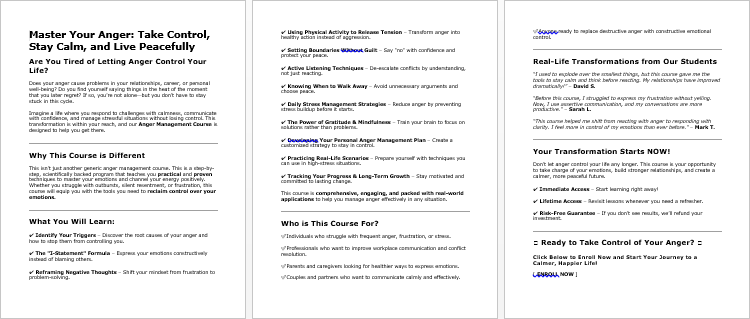
Package Details:
Word Count: 20 450 Words
Number of Pages: 106
Anger Management – Bonus Content
Checklist
Word Count: 392 words
FAQs
Word Count: 946 words
Salespage Content
Word Count: 583 words
Total Word Count: 22 371 Words
Your PLR License Terms
PERMISSIONS: What Can You Do With These Materials?
Sell the content basically as it is (with some minor tweaks to make it “yours”).
If you are going to claim copyright to anything created with this content, then you must substantially change at 75% of the content to distinguish yourself from other licensees.
Break up the content into small portions to sell as individual reports for $10-$20 each.
Bundle the content with other existing content to create larger products for $47-$97 each.
Setup your own membership site with the content and generate monthly residual payments!
Take the content and convert it into a multiple-week “eclass” that you charge $297-$497 to access!
Use the content to create a “physical” product that you sell for premium prices!
Convert it to audios, videos, membership site content and more.
Excerpt and / or edit portions of the content to give away for free as blog posts, reports, etc. to use as lead magnets, incentives and more!
Create your own original product from it, set it up at a site and “flip” the site for megabucks!
RESTRICTIONS: What Can’t You Do With These Materials?
To protect the value of these products, you may not pass on the rights to your customers. This means that your customers may not have PLR rights or reprint / resell rights passed on to them.
You may not pass on any kind of licensing (PLR, reprint / resell, etc.) to ANY offer created from ANY PORTION OF this content that would allow additional people to sell or give away any portion of the content contained in this package.
You may not offer 100% commission to affiliates selling your version / copy of this product. The maximum affiliate commission you may pay out for offers created that include parts of this content is 75%.
You are not permitted to give the complete materials away in their current state for free – they must be sold. They must be excerpted and / or edited to be given away, unless otherwise noted. Example: You ARE permitted to excerpt portions of content for blog posts, lead magnets, etc.
You may not add this content to any part of an existing customer order that would not require them to make an additional purchase. (IE You cannot add it to a package, membership site, etc. that customers have ALREADY paid for.)
Deprecated: Function post_permalink is deprecated since version 4.4.0! Use get_permalink() instead. in /home/buyqualityplr/public_html/wp-includes/functions.php on line 6121
Share Now!

